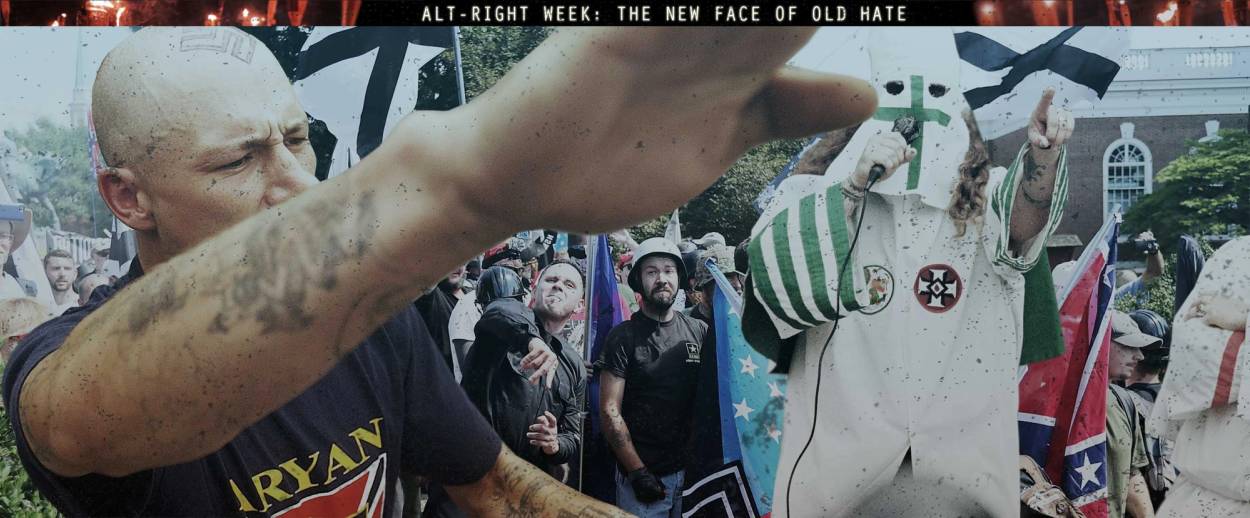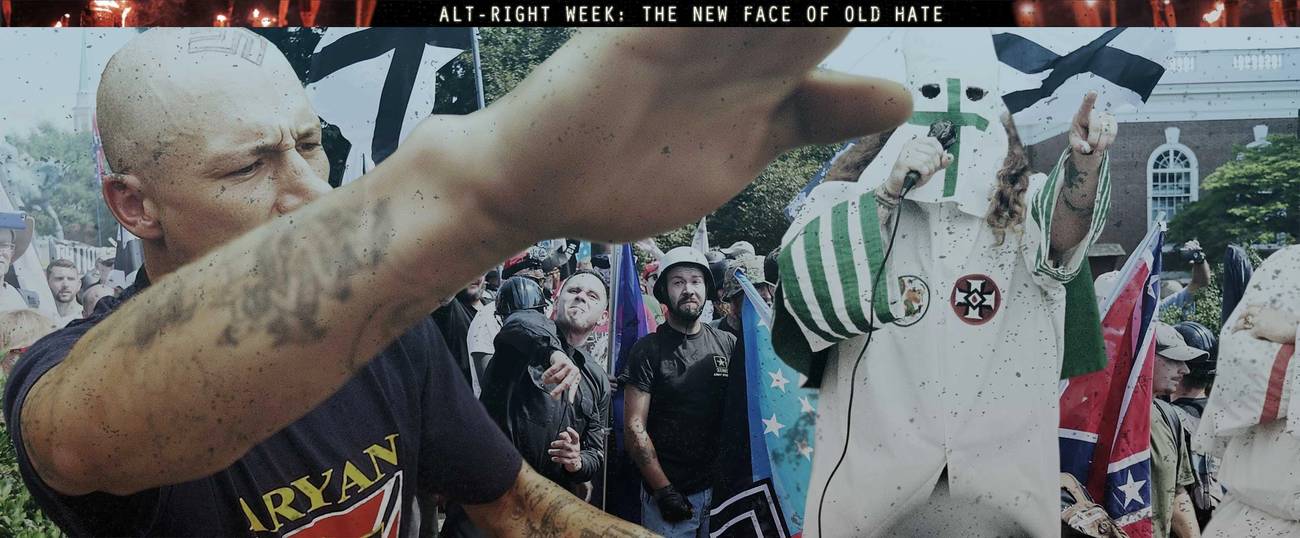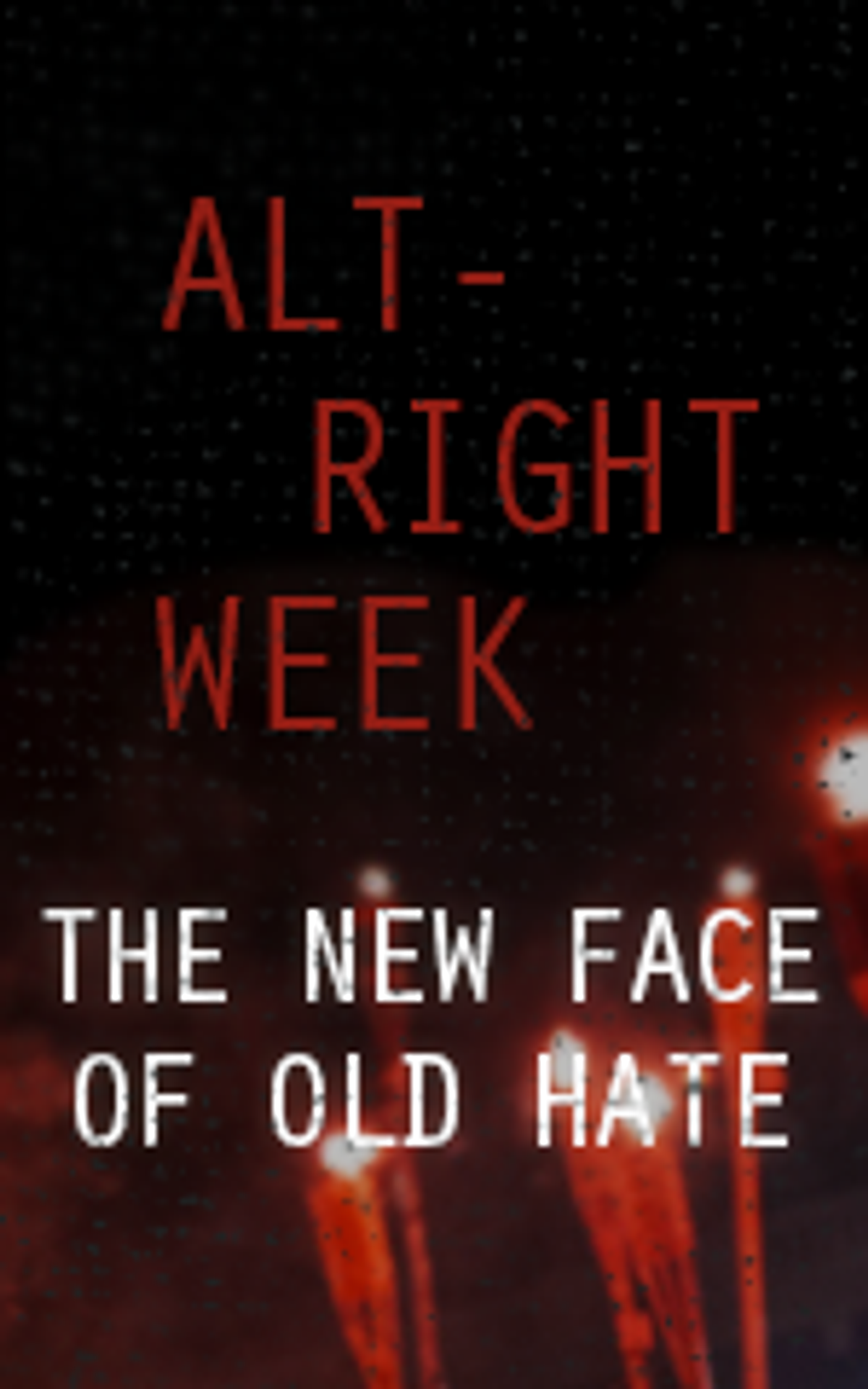What Is the American Far Right?
And how many of them are there, anyway?




Today’s far-right is a congeries of self-identified “sovereign citizens” (who, like Walt Whitman, believe they are “entire unto themselves”), “3%ers” (an allusion to the mythical number of Americans who fought the British during the Revolutionary War), and elderly white tea-party retirees on Medicare and Social Security who resent having to support “free-loaders” (“Not my child, not my problem!”). There are also play-acting pagan Odinists, “f**k yeah” gun-nuts, and bored millennials enchanted by Ayn Rand’s hero, John Galt, of Atlas Shrugged. In addition to buttoned-down Mormon “freemen,” camouflaged border vigilantes, black-clad neo-Nazi stormtroopers, and their Confederate-flag-waving cousins, there are sellers of over-the-counter male-enhancement cures and rare coins, Czech gas masks, cheap Belize real estate, and “White Pride World Wide!” coffee mugs, ball caps, and bumper stickers, alongside vendors of unregulated nutraceuticals, survival go-packs, and home security systems. These and countless other trajectories are overseen by a handful of billionaire funders of nontaxable “educational foundations,” staffed with the “great minds” of the “conservative movement.”
This poses a problem for analysts: How do we count their number? Given, one, their overlapping and sometimes contradictory affinities; two, that group names and individual affiliations are transitory; and three, that far-right operatives have seized control of GOP apparatuses throughout the Deep South, the Midwest, and the Rocky Mountain region, lending them a patina of conventional legitimacy, the short answer is: No one can be certain. But this, we do know.

First, the American appetite for right-wing extremism has always been relatively small. Citing survey data gathered in 2013 by the highly respected Pew Research Center, Devin Burghart reports that only 0.14 percent of Americans (i.e., 14 for every 1000 citizens) admitted to being dues-paying members of the tea party, the most newsworthy radical-right grouping of our era. He estimates the number of “sympathizers” varies anywhere from 20 percent to 40 percent of the public depending on the crisis of the moment, and that active supporters (as indicated by Facebook “likes”) compose just 2 percent. Continuing a pattern that goes back at least six decades, the large majority of tea-partiers are white males from the sparsely populated states of Alaska (No. 1 in terms of per-capita membership), Montana (No. 2), Wyoming (No. 3), and Idaho (No. 4). This comports exactly with data gathered in the 1980s on the per-capita number of right-wing extremist headquarters by state.
Second, whatever its reputed size, American right-wing extremism is a cyclical phenomenon. In other words, while there has never been a time without government-bashing bigots and racists, there are definite moments when this sentiment captures the popular imagination. But just as quickly, it dissipates like morning fog. Without being overly mechanical about it, these upsurges seem to occur about once every 30 years or so. The Arthur Schlesingers, Sr. and Jr., who use a 30-year marker to explain American political dynamics, argue that economic booms and busts may affect the amplitude of extremist outbursts, but by themselves, have little connection to when they occur. Instead, they attribute the upsurges to successive younger generations for whom far-right ideas are still fresh and exciting. Owing to financial impropriety, threats of violence, sexual shenanigans, and mostly because its policies fail to address what stoked them in the first place, past American rightist insurgencies have always ended amidst finger-pointing, recrimination, and schism. Whether today’s far-right will follow suit remains to be seen.
The first time one of these outbursts occurred was in 1800, and it concerned rumors of an Illuminati Conspiracy Against All the Religions and Governments of Europe (a pamphlet authored by John Robison in 1798). In response, the Federalist Party, led by staid “Presbygationist” ministers, enacted legislation to fend off the threat from Jeffersonian “seditionists” (and rowdy Methodist and Baptist tent preachers) and foreign (read: Irish) “aliens.” As it turned out, the effort failed; Jefferson became president and turned the same laws against his opponents.
In 1830 a new menace appeared, Freemasonry. Stories were told of its ties to an “un-American” Christian cult called Mormonism. Legend at the time insinuated that the word ‘Mormon’ itself was concocted from the last names of two men allegedly murdered by the Masons for revealing its wickedness to the public: William Morgan and Timothy Monroe. An Anti-Masonic Party was founded. It briefly rose to prominence, then disappeared.
A generation later there were announcements of an even more sinister specter. It seems that a cabal of Yankee abolitionists was plotting to destroy the slave economy of the South. As proof, Southern Secessionists cited a “war of Northern aggression” declared on them by a silver-tongued “tyrant” misnamed “Honest” Abe. True, so the story went, his Emancipation Proclamation did free the slaves, but only in the Confederate states! “Hypocrisy!”
Catholicism has always been an object of detestation for American WASPs. Witness the Know Nothing Party, an anti-Irish, anti-German Catholic movement which eventually split over the question of slavery. In the 1890s, however, a new kind of Catholic began arriving on American shores, swarthy and black-haired. They were accused of carrying with them Jesuitical plans to impose papist rule across country (rumors which are hard to believe today but resemble contemporary anti-sharia hysteria). A nativist American Protection Association was cobbled together and soon grew into the largest political action group seen up to that time (with 3 million members). And with it an Anti-Saloon Party that offered a new way to fight an old foe, with symbols instead of guns. Don’t fight them directly, went the theory, but fight the intoxicants stereotypically associated with them: beers, wine, and whiskey. America’s first “war on drugs” was declared. It eventually culminated in a Prohibition Amendment to the Constitution.
Which takes us to the 1920s and the first “red scare” (the second would occur 30 years later). This was a period of anti-black lynch mobs, Asian immigration restrictions, and most notably a resuscitated Ku Klux Klan to replace the terrorist groups that flourished in the South during Reconstruction. The menace of international Communism was discovered, a loathsome entity that propaganda connected to union thugs, sympathetic Jewish “pinheads,” and once again, slavish Catholics. After taking control of state governments from Indiana to Oregon, by the 1930s this too had lost its luster, this time to the Great Depression and war.
In the 1950s, war-hero “tail gunner” Joe McCarthy emerged. He not only revived memories of COMINTERN but testified that it had infiltrated the State Department and Hollywood studios; this, as its front-men “brainwashed” American youth from college lecterns. Loyalty oaths were ordered, investigations conducted into subversion, and those who objected were blacklisted. Yet within a few years, this too had passed.
In 1980, a so-called Moral Majority staged a gigantic “Washington for Jesus” parade that helped ignite the “Reagan Revolution.” In the face of a “holocaust” of abortions, its goal was to defend “traditional family values” against the carriers of “secular humanism”: liberal professors, civil-rights activists, and female liberationists. The more Reaganites took up arms, banded together in militias, and conducted secret “military” exercises. But then in 1995, it all collapsed, when a disgruntled Iraq-war vet, Timothy McVeigh, blew-up a federal building, killing 168 clerks and preschoolers.
***
The only thing that differentiates today’s far-right ideologically from precursors are its targets. Instead of Masons or Mormons, abolitionists, Catholics, Jews, or Commies, they are uppity gays and transgender kids, litigious “femi-Nazis,” Muslim refugees, and Hispanic immigrants. Everything else has remained the same. The same noisy bombast and buffoonery, the same recital of affronts to righteousness, the same tales of a diabolic plot, the same prognostications of Armageddon, the same promises of a happy ending.
Apart from its cathartic appeal, the term fascism is inadequate for understanding the American far-right (as is conservatism, which should become clear below). Ignoring the fact that the term was not even coined until the 1920s, and then in Italy, “the word fascism, to quote George Orwell, “is … almost entirely meaningless, except in so far as it signifies ‘something not desirable.’ ” Nowadays, it is ritually invoked to defame everything from “Islamo-fascism” to compulsive gym-going (“body fascism”), and from “technofascism” (machine music) to “eco-fascism,” “homo-fascism,” and, ironically, “liberal fascism,” on and on. More than empty, however, the word is misleading. True, minute numbers of Americans like to scandalize neighbors by dressing-up in jodhpurs, riding boots, and swastikas, but American extremism has never been a foreign import. Instead, it is a homegrown product.
Unlike the secularized, pseudoscientific oratory reminiscent of continental European-style fascisms, American far-right rhetoric has always been inflected with Christian evangelicalism. Indeed, as far back as 1800, its major spokesmen have been preachers of the Gospel. Think of Billy Sunday or Father Coughlin, or the Revs. Carl McIntire (head of the Christian Anti-Communist Crusade of the 1950s), G. L. K. Smith (founder of the Cross and Flag), and Gerald Winrod (the “Jayhawk Nazi”); or in our era, Revs. Jerry Falwell, Franklin Graham, and Robert Jeffress. This explains its emblematic obsession with “sodomy,” meaning whatever frustrates the “natural end” of sexuality: contraception, masturbation, pedophilia, and the “end-times abomination” (homosexuality), and with potentially compromising activities like “the devil’s anthem” (rock ’n’ roll and jazz, two colloquial references to sex), the “new addiction” (pornography), close dance, “hot drinks” (coffee and tea), and “drugs.”
The evangelical tenor of the American far right is nowhere more evident than in what is its most influential modern standard bearer, Christian Dominionism (CD). Estimates are that over 80 percent of CDs supported Donald Trump in the 2016 presidential election. CD gets its inspiration from the Book of Genesis, which commands believers to dominate “all that moveth upon the earth,” including non-Dominionists.
There are different flavors of CD. The smallest, but most well-known, is Christian Identity. This claims that white Europeans (“Aryans”) are descended from one or more of the legendary Lost Tribes of Israel—Denmark from the Tribe of Dan, for example, or Jutland from Judah, etc.—that therefore they, not Jews, are the Chosen People of God; and that Jesus was not a Semite but a blue-eyed, brown-haired German. Christian Identity was the inspiration for The Brüders Schweigen (German for “Secret Brotherhood”), one of the most murderous terrorist groups operating in America during the last century, headquartered in the upper Rocky Mountains. Authorities believe that Timothy McVeigh, mentioned earlier, was an adherent of Christian Identity.
An eminently more widespread, far less violent, variant of CD is premillennial dominionism, of which the New Apostolic Reformation, a Pentecostal theological movement (not an organization with members) largely centered in Texas, Oklahoma, Missouri, and Colorado, is the best example. By “premillennial” is meant a biblical exegesis that insists that Christ—here, configured as a Jew—will come prior to the thousand-year reign of peace and justice prophesied in Revelations. Churches associated with New Apostolic Reformation market themselves through slickly-produced cable TV shows, private schools, and elaborate publishing enterprises. In this way, New Apostolic Reformation groups have been able to penetrate mainstream evangelical Protestantism. Ministers and churches associated with the New Apostolic Reformation have supported the presidential ambitions of Sarah Palin and Michele Bachmann (both of whom are Pentecostals), and Rick Perry, onetime Texas governor.
Still a third variety of CD is Christian Reconstruction, as represented by, among others, Rev. Pat Robertson, founder of the Christian Coalition and Regent University. Re-construction, because it holds that if America is to be saved, it must return to what presumably prevailed at the time of its founding. Christian Reconstruction repudiates premillennialist dominionism, which ostensibly advocates patiently waiting for the Rapture. This, Reconstructionists consider self-seeking and pacifistic. (In truth, these are two of its attractions for its prosperous, white suburban congregants.) Reconstructionists insist on the contrary that the Second Coming can occur only after America has been rebuilt to biblical specifications. This gives its politics noticeable urgency.
There is little evidence for the popular theory that right-wing extremists are abnormally SIC: stupid, isolated, or crazy.
All forms of Christian Dominionism share the same two elements. First, is the conviction that there exists a Plot, a “breathing together” of a cabal to “satanify” the nation; that every private and public concern, real or imagined—from insomnia and the opioid crisis to mass murders and hurricanes—is attributable to this cabal; that if nothing is done, the End of the World is imminent; and that claims about the Plot are irrefutable. (How, after all, can one disprove the existence of a “Hidden Hand,” of a “Shadow Government,” or a “Gray State?”). The second element is a proposed solution: the remaking of America after the “organic Constitution” (the original articles plus the Bill of Rights) and the Bible. The former is to be understood in an “originalist” way, according to the presumed intent of the Founding Fathers; the latter is to be read literally.
Implementation of the organic Constitution will rescission of the 13th, 14th, and 15th Amendments to the Constitution (that respectively outlaw slavery, grant equal rights to ex-slaves [and recently, to various minorities], and provide police powers to enforce these); the 16th Amendment, which establishes an Income tax; the 17th, which allows for the direct election of senators; the 19th, which grants women the right to vote; and the 26th, which does the same for 18-year-olds.
In regard to the Bible, the idea is that unless expressly abrogated by a teaching of Jesus and/or the Apostles, each and every Old Testament ruling shall be binding in a reconstructed America. Thus, insofar as neither Jesus nor the Apostles say anything against it even when given the opportunity to do so, debt slavery for non-Christian guest-workers shall be permitted. As well as the denial to them of civil rights. It also means witches, abortionists, soothsayers, disobedient youth, women who lie about their virginity, blasphemers, false witnesses, adulterers, and homosexuals shall be subjected to stiff criminal punishment.
The proposed reconstruction of America involves four steps: First, pass a balanced-budget amendment to the Constitution, so the federal government cannot spend beyond its means. Second, “Starve the Beast!” (an allegorical allusion to the government) by replacing the income tax with a system that “God favors,” (say, Herman Cain’s “nine, nine, nine” program). Third, slash every considered non-biblical, unconstitutional government program, agency, and department, including the Department of Energy, the EPA, the Forest Service, the Labor Relations Board and OSHA; the NSF, NPR, and PBS; consumer-protection laws; and Medicare, Medicaid, Obamacare, and Social Security. Fourth, privatize those services deemed essential for the functioning of society: the mail, education, highways, and dams; policing, fire protection, prisons, and military defense. Shelter, food, and health care for the indigent shall be charged to charitable NGOs, along the lines of “compassionate conservatism.”
***
Right-wing insurgencies occur once every 30 years or so. With the exception of the antebellum South, however, only a small portion of a given generation is drawn to them. So what is it that differentiates joiners from the rest? To begin with, there is little evidence for the popular theory that right-wing extremists are abnormally SIC: stupid, isolated, or crazy. On the contrary, they appear to have attained levels of formal education comparable to their more moderate peers. And even the most vicious among them who, if not dead, is moldering in federal prison, cannot be shown to be clinically insane. Finally, given that people are radicalized via social networks—family ties, co-workers, and friends—true isolates are the least likely to become activists themselves. In fact, the marriages of right-wing radicals are about as stable as those of the average citizen, and while most do reside in rural districts, they are generally no more transient, or out of local communication loops, than their neighbors.
In The Origins of Totalitarianism, Hannah Arendt offers an alternative explanation for far-right insurgencies. Right-wing radicals, she argues, are “superfluous men” (which, of course, includes women), a phrase she borrows from Maurice Barrès, who used it to describe those who were flocking to his proto-fascist gatherings in the 1890s. (Barrès is credited with coining the term “national socialism.”) These are people resentful at having been marginalized by the juggernaut of modernization or, as it is known, “globalization”: the import of cheap foreign labor into the home country, who are then granted equal rights; the export of manufacturing capital to low-paying nations; and most importantly, technological disruption, the displacement of workers by robots and machines. When the superfluous person in question has a sense of white, male, sexually-straight, Christian entitlement, they feel doubly or triply aggrieved at their fate.
Arendt tells how, through the first half of the 20th century, political plague-mongers encouraged superfluous men to see themselves not as “little men,” as “forgotten Americans,” or as “losers” (to use the recent label), but as “supermen” upon whose shoulders the fate of Western civilization rests. And, they urged them to direct their fury against imaginary forces like the “Dark Command,” “Force X,” or the “Deep State”; or against on visible tokens of their displacement: refugees, undocumented immigrants, domestic minorities, and local deviants.
The reason why this country has been able to generate an endless supply of bigots, racists, and misogynists, Arendt would say, is because in America no one’s status is ever permanently secure. The problem for rightists is that no amount of wall-building, minority-voter restrictions, or anti-Sharia laws are likely to change this. Nor will defunding of public school, anti-union “right to work” laws, privatization of national parks, open-carry gun laws, bathroom bills, or creation science.
James Aho is Professor Emeritus of Sociology at Idaho State University. He has authored three books on American right-wing extremism. His latest isFar Right Fantasy.